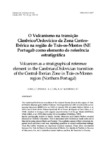Mostrar o rexistro simple do ítem
O Vulcanismo na transição Câmbrico/Ordovícico da Zona Centro-Ibérica na região de Trás-os-Montes (NE Portugal) como elemento de referência estratigráfica
| dc.contributor.author | Coke, C. | |
| dc.contributor.author | Pires, C. A. Coelho | |
| dc.contributor.author | Sá, A. A. | |
| dc.contributor.author | Ribeiro, A. | |
| dc.date.accessioned | 2010-01-25T09:38:45Z | |
| dc.date.available | 2010-01-25T09:38:45Z | |
| dc.date.issued | 2001 | |
| dc.identifier.citation | Cadernos do Laboratorio Xeolóxico de Laxe, 2001, 26: 121-136 ISSN: 00213-4497 | es_ES |
| dc.identifier.issn | 0213-4497 | |
| dc.identifier.uri | http://hdl.handle.net/2183/6529 | |
| dc.description.abstract | The Cambrian/Ordovician transition of the Central Iberian Zone in the region of Trás -os-Montes displays quite distinct features. One is gradational with no noticeable unconformity: Moncorvo (REBELO et al , 1983); S. Gabriel, NW of Castelo Melhor (SILVA et al, 1991); and S limb of the Poiares synclinal, SE of Freixo de Espada à Cinta (Silva et al. 1994). Another is brusque with angular unconformity: E of the gv Marão (RIBEIRO, 1962; COKE, et al. 1993); Sião brook, NE of Pardelhas (PEREIRA, 1987). Recent petrography studies in Marão, Eucísia, Moncorvo and Castelo Melhor revealed siliceous (or riolithic) volcanism. This is associated with Ordovician basal units and is bimodal in some places (Marão and Eucísia). The explosive nature of that volcanism dispersed much ash over a vast area, depositing quantities in several sedimentary settings. Thus, the tuffitic horizons are important transient markers. These allow correlations between Fm. Vale de Bojas in the mountain of Marão, Fm. Quinta da Ventosa in the area of Moncorvo, Fm. de S. Gabriel in Castelo Melhor; and Fm. de "Serrinha" in Eucísia. The coexistence of an angular unconformity and disconformity in the mountain of Marão suggests the occurrence of some emerged areas. In the area of Quinta do Cuco (Moncorvo), this emergence is inferred by the presence of striped phyllite clasts (evidently from Fm. de Desejosa) in the overlying conglomerate. On the hill of S. Gabriel in Castelo Melhor, a gradual transition in the overlying volcanic unit without conglomerate levels, suggests a more distal environment. Observations support the hypothesis of an intracratonic rift in the Upper Cambrian Proterozoic with active faults at the margins were subject to a precocious tectonic inversion involving a right transpression to that following the Varisc compression. This perpendicular left transpression to the axis of the trench discharged bimodal volcanism and produced wide cleavage-free folds (RIBEIRO et al, 1991. | |
| dc.language.iso | por | es_ES |
| dc.publisher | Universidade da Coruña | es_ES |
| dc.subject | Lower Ordovician | es_ES |
| dc.subject | Pre-orogenic volcanism | es_ES |
| dc.subject | Acid volcanism | es_ES |
| dc.subject | Lithostratigraphic correlation | es_ES |
| dc.subject | Autochthonous of the Central Iberian Zone | es_ES |
| dc.title | O Vulcanismo na transição Câmbrico/Ordovícico da Zona Centro-Ibérica na região de Trás-os-Montes (NE Portugal) como elemento de referência estratigráfica | es_ES |
| dc.title.alternative | Volcanism as a stratigraphical reference element in the Cambrian/Ordovician transition of the Central-Iberian Zone in Trás-os-Montes region (Northern Portugal) | |
| dc.type | info:eu-repo/semantics/article | es_ES |
| dc.rights.access | info:eu-repo/semantics/openAccess |






